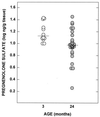Neurosteroids: deficient cognitive performance in aged rats depends on low pregnenolone sulfate levels in the hippocampus
- PMID: 9405705
- PMCID: PMC25129
- DOI: 10.1073/pnas.94.26.14865
Neurosteroids: deficient cognitive performance in aged rats depends on low pregnenolone sulfate levels in the hippocampus
Abstract
Pregnenolone sulfate (PREG S) is synthesized in the nervous system and is a major neurosteroid in the rat brain. Its concentrations were measured in the hippocampus and other brain areas of single adult and aged (22-24 month-old) male Sprague-Dawley rats. Significantly lower levels were found in aged rats, although the values were widely scattered and reached, in about half the animals, the same range as those of young ones. The spatial memory performances of aged rats were investigated in two different spatial memory tasks, the Morris water maze and Y-maze. Performances in both tests were significantly correlated and, accompanied by appropriate controls, likely evaluated genuine memory function. Importantly, individual hippocampal PREG S and distance to reach the platform in the water maze were linked by a significant correlation, i.e., those rats with lower memory deficit had the highest PREG S levels, whereas no relationship was found with the PREG S content in other brain areas (amygdala, prefrontal cortex, parietal cortex, striatum). Moreover, the memory deficit of cognitively impaired aged rats was transiently corrected after either intraperitoneal or bilateral intrahippocampal injection of PREG S. PREG S is both a gamma-aminobutyric acid antagonist and a positive allosteric modulator at the N-methyl-D-aspartate receptor, and may reinforce neurotransmitter system(s) that decline with age. Indeed, intracerebroventricular injection of PREG S was shown to stimulate acetylcholine release in the adult rat hippocampus. In conclusion, it is proposed that the hippocampal content of PREG S plays a physiological role in preserving and/or enhancing cognitive abilities in old animals, possibly via an interaction with central cholinergic systems. Thus, neurosteroids should be further studied in the context of prevention and/or treatment of age-related memory disorders.
Figures



 )
(n = 15), whose score was below the median value;
unimpaired rats (○) (n = 15), whose
score was above median. The mean value of the impaired group did not
differ from chance level (t = 1.0,
df = 14, ns), while the mean value of the
unimpaired group differed from chance level (t =
6.0, df = 14, ns). (B) The impaired animals
(n = 15) were split into two subgroups. Vehicle
injection had no effect on the performances of impaired rats
(n = 8) in the Y-maze (ITI = 6 h). In
contrast, the subgroup treated with PREG S (n = 7)
performed significantly above chance level 7 h postinjection
(t = 5.5, df = 6; ∗,
P < 0.02), but returned to chance level 10 days
later (t = 2.0, df = 6, ns).
)
(n = 15), whose score was below the median value;
unimpaired rats (○) (n = 15), whose
score was above median. The mean value of the impaired group did not
differ from chance level (t = 1.0,
df = 14, ns), while the mean value of the
unimpaired group differed from chance level (t =
6.0, df = 14, ns). (B) The impaired animals
(n = 15) were split into two subgroups. Vehicle
injection had no effect on the performances of impaired rats
(n = 8) in the Y-maze (ITI = 6 h). In
contrast, the subgroup treated with PREG S (n = 7)
performed significantly above chance level 7 h postinjection
(t = 5.5, df = 6; ∗,
P < 0.02), but returned to chance level 10 days
later (t = 2.0, df = 6, ns).

References
-
- Schumacher M, Robel P, Baulieu E E. Dev Neurosci. 1996;18:6–21. - PubMed
-
- Bitran D, Purdy R H, Kellogg C K. Pharmacol Biochem Behav. 1993;45:423–428. - PubMed
-
- Roberts E. In: The Biological Role of Dehydroepiandrosterone (DHEA) Kalimi M, Regelson W, editors. Berlin: de Gruyter; 1990. pp. 13–42.
-
- Mayo W, Dellu F, Robel P, Cherkaoui J, Le Moal M, Baulieu E E, Simon H. Brain Res. 1993;607:324–328. - PubMed
Publication types
MeSH terms
Substances
LinkOut - more resources
Full Text Sources
Other Literature Sources
Medical

